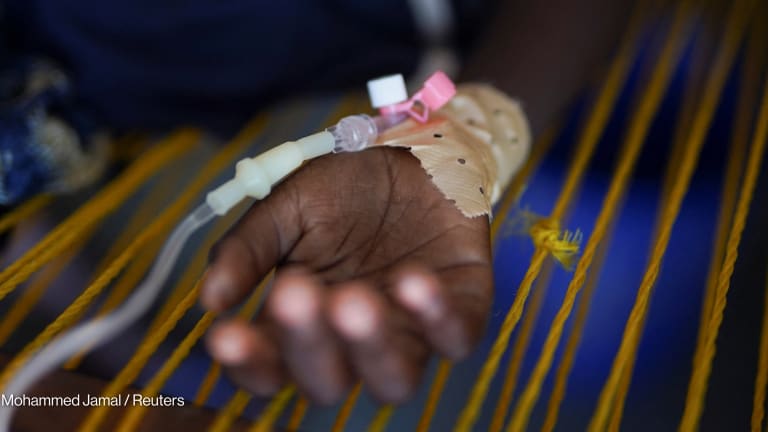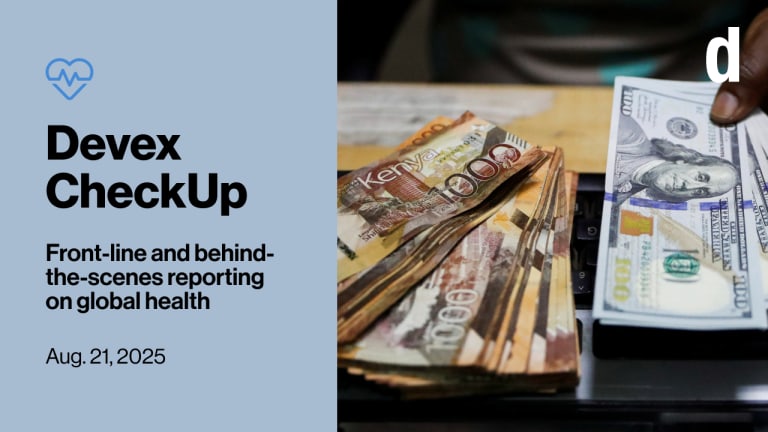
Cholera outbreaks are widespread and more deadly these days — popping up in places that haven’t seen them in years.
According to the World Health Organization, 29 countries have already reported cholera this year. Syria, Malawi, and Haiti are currently wrestling with especially large outbreaks.
In the past five years, less than 20 countries, on average, reported outbreaks per year.
Climate change is largely to blame for the uptick, experts said, as waters warm and violent weather is more frequent.
Before COP 27, join Devex and a panel of experts, including Moazzam Malik of World Resources Institute, to get ahead of the discussions and hear about the key issues to watch. Register now.
“We've seen a dramatic increase in the number of cases of cholera,” said Raoul Kamadjeu, health specialist in public health emergencies at UNICEF. "We are also observing that countries that have not reported cholera in many, many years, now are starting to report cholera.”
This month, Lebanon reported its first cholera outbreak since 1993. Syria is experiencing its first outbreak since 2009. Haiti, after more than three years with no cases, has an outbreak in the capital city of Port-au-Prince.
The demand is so high for cholera vaccines — used as a preventive measure and an outbreak response — that WHO and its partners said last week there are not enough and lowered the recommended doses from two to one to broaden access. With two doses, someone is protected for at least three years. One dose still provides immunity, although it's unclear the length of protection.
In a press conference earlier this month, WHO chief Tedros Adhanom Ghebreyesus said after years of declining cases, cholera is making an “unwelcome comeback.” He said the average case fatality rate this year is nearly three times the rate of the past five years. Cholera can kill within hours if left untreated.
“Cholera thrives on poverty and conflict but is now being turbocharged by climate change,” he said.
Warming waters and calamitous weather
Dr. Rita Colwell, an American microbiologist who is currently serving as a distinguished university professor at the University of Maryland at College Park and at Johns Hopkins University Bloomberg School of Public Health, has researched cholera for decades. In the 1960s, she discovered that vibrio cholerae — the bacteria that causes cholera — lives on microscopic zooplankton, which are aquatic organisms.
Her teams have analyzed decades of data from zooplankton from the North Sea, coupling it with data on warming waters. They’ve demonstrated the vibrio cholerae increased year over year, as water temperature increased. “It's not a tremendous increase, but it's measurable — and it's significant in terms of the numbers of infections,” she said.
“That was, I think, the first demonstrated direct correlation of a changing climate and infectious disease,” she said.
“With climate change and the warming of certain water places and deltas in the world, we see that bacteria can multiply much faster and this is why also we have much bigger outbreaks in certain places in the world,” said Dr. Sylvie Briand, director of global infectious hazard preparedness at WHO, during a press briefing.
“Pre-emptive public health is what we desperately need.”
— Dr. Rita Colwell, distinguished university professor, University of Maryland and Johns Hopkins University Bloomberg School of Public HealthBut it's not just the warming waters. For a slow-onset crisis like drought, the link with a water-borne disease such as cholera isn’t obvious — as this is a time when water is scarce. But as fresh water is less available, people are often left with water contaminated with nutrient-rich sediment, teeming with plankton that can be coated with vibrio cholerae. In areas with bad sanitation, a person with cholera excretes that bacteria and it continues to contaminate the environment.
And during drought, many children are malnourished.
"If they get cholera and don't go directly to the health center, they will die in hours," said Alexandra Machado, senior officer in the water sanitation and hygiene unit at the International Federation of Red Cross and Red Crescent Societies. Families may not know the severity of the situation and don’t act quickly, or the child is treated but returns home to drink the same contaminated water.

Extreme weather such as floods, monsoons, cyclones, and hurricanes, also stir up sediment-contaminated water and destroy water and sanitation infrastructure — often leeching sewage into the water.
For example, the worst flooding in more than a decade has driven a major increase in cholera cases in Nigeria and cholera outbreaks in Malawi followed tropical storms.
And these weather events spur widespread migration as people uproot their lives in search of water or after their homes were destroyed. Resource depletion caused by conflict can also forcibly drive people from their homes.
Displacement camps are often crowded with inadequate sanitation. And people can bring cholera from one country to another.
The disease is spreading in refugee camps in Lebanon, after it crossed over from Syria. It is also spreading in a refugee camp in Cameroon.
Hard to test, easy to treat
One case of cholera constitutes an outbreak — but this declaration isn’t simple. Governments are the only ones who can officially announce an outbreak. And politics are involved because cholera is stigmatized as a disease of poverty — so some governments avoid a declaration.
A WHO spokesperson said countries don’t always report outbreaks to WHO and the agency doesn’t publish a full list of country outbreaks because they want to encourage the sharing of information.
Governments sometimes instead opt for saying there is acute watery diarrhea — which is the umbrella term for a broader range of diarrheal diseases. Cholera is a severe form that includes diarrhea and vomiting.
But sometimes countries actually don’t know if cholera is within their borders. At the community level, tests are often not available, IFRC’s Machado said. To declare cholera, it's necessary for laboratories to collect fecal specimens from suspected patients. Because of this, cholera cases are underreported.
From our archives:
► Q&A: Bangladesh cholera expert on how to train personnel worldwide
► The world's leading 'cholera hospital' looks to the future
► Nigeria tackles cholera outbreak using housecalls, jingles, and health advisories
She said colleagues in flood-impacted Pakistan don’t know if they are responding to cholera or other forms of acute watery diarrhea because of the lack of tests.
But WHO has clinical definitions around cholera when access to diagnostic laboratory testing is difficult. Machado added the way they respond is the same regardless of if it's cholera or acute watery diarrhea. Treatment is straightforward and includes hydrating people through oral rehydration salts or antibiotics in severe cases.
Some of the countermeasures include training community volunteers in surveillance, setting up oral rehydration points, chlorinating water, contact tracing, educating communities on sanitation measures, and working to avoid the spread to others by ensuring bodily fluids of infected people are contained. The bacteria is present in feces for up to 10 days after infection.
If an outbreak is identified on time and cases are managed properly, the death rate is less than 1%. But without treatment — which is not always accessible — up to half of infected people die from severe cholera.
Investments in sustainable, long-term water sanitation and hygiene solutions are needed, Machado said, adding that many health centers in low-income settings have no handwashing facilities.
“If not, we are running every year to the same emergency situations,” Machado said.
While expanding manufacturing in the short-term is not an option, WHO is calling for a ramp-up in the manufacturing of vaccines so that outbreaks can be prevented in places where the bacteria is in the environment.
“In the long-term we need a plan to scale up vaccine production as part of a holistic strategy to prevent and stop cholera outbreaks,” Ghebreyesus said.
Right now, there is also an “extremely constrained supply for oral cholera vaccine,” UNICEF’s Kamadjeu said. This year, countries have requested 36 million doses of cholera vaccine, while the global stockpile has only about 4.6 million doses, he said.
“We just don't have enough doses. But luckily, the cholera vaccine, even one dose, provides an immunity that is sufficient to control an outbreak,” Kamadjeu said.
If a country is not able to declare a cholera outbreak, it is more difficult to access vaccines, Machado said. But there have been cases such as in Bangladesh during the Rohingya crisis or in Mozambique after Cyclone Idai where oral cholera vaccination campaigns were held without a cholera declaration.
"It is unsure how this will be managed with the unprecedented pressure on the limited vaccine stockpile," she said.

Spotted from the skies
And there are efforts to innovate around cholera management. Colwell and her colleagues at the University of Florida, including Dr. Antarpreet Jutla, as well as the United Nations, and the National Aeronautics and Space Administration, are using remote satellite sensing, artificial intelligence, and machine learning to gather data on water temperature and chlorophyll in order to measure plankton populations.
Satellites cannot measure zooplankton through sensors, but phytoplankton that carry chlorophyll can be measured — which is an indicator of the presence of the vibrio cholerae bacteria, which lives on the zooplankton that eat phytoplankton. So ultimately, the satellite imagery can be used to raise the alarm that chlorophyll is on the rise — which in turn means in about six to eight weeks there will be an increase in zooplankton, and thus, could lead to an outbreak of cholera. That information is coupled with information on water temperature and the presence of human populations.
They’ve developed a predictive risk model to warn governments in Ethiopia and Yemen that cholera outbreaks could occur. The public health authorities can then prepare for an outbreak with a few weeks head start. They have also conducted work in Mozambique and Senegal and are looking to expand to Ghana.
“Pre-emptive public health is what we desperately need,” Colwell said.









